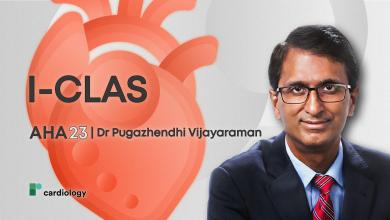Search results
Author(s):
Jonathan S Steinberg
,
David Slotwiner
Added:
3 years ago
Electrical Remodelling
Evidence Supporting Atrial Remodelling
The concept of electrical remodelling was first introduced in 1995 simultaneously by Wijffels et al.1 and Morillo et al.2 who demonstrated that once sustained atrial fibrillation (AF) was induced in goats, or rapid atrial pacing was performed in dogs, physiological changes occurred that favoured the maintenance of AF.3 This led to the…
View more
Author(s):
Michael R Gold
Added:
2 years ago
In this video, Dr Michael R Gold (Medical University of South Carolina, Charleston, SC, US) shares the primary results of the Smart-CRT Trial. The study investigated the efficacy of an atrioventricular optimization algorithm to improve reverse remodeling among patients undergoing cardiac resynchronization therapy (CRT) in the presence of interventricular electrical delay.
Discussion Points…
View more
Author(s):
Khang-Li Looi
,
Anthony SL Tang
,
Sharad Agarwal
Added:
3 years ago
Heart failure (HF) is a growing and major health burden in western countries. The prevalence of HF is estimated at 1–2 % in the western world, and the incidence approaches 5–10 per 1,000 persons per year.1Cardiac resynchronisation therapy (CRT) has been shown in multiplestudies to improve HF symptoms, quality of life and improve survivals.2–6The two landmark studies, Comparison of Medical Therapy…
View more
Author(s):
Pugazhendhi Vijayaraman
Added:
5 months ago
AHA 2023 — In this short interview, we are joined by Dr Pugazhendhi Vijayaraman (Geisinger Heart Institute, US) to discuss the findings of the I-CLAS study, an international collaborative investigation into left bundle branch area pacing.This retrospective observational study compared the arrhythmic risk in biventricular pacing as compared to left bundle branch area pacing. 1778 Patients were…
View more
Author(s):
Henry Chubb
,
John Whitaker
,
Steven E Williams
,
et al
Added:
3 years ago
Atrial Septal Defects and Patent Foramen Ovale
Nomenclature
The atrial septum is a complex structure, with the true septum comprised of two layers containing a potential flap valve. The septum primum extends from caudal to cranial within the atria, on the left side of the septum secundum. The septum secundum is a crescent-shaped infolding of the atrial roof, extending from the anterosuperior…
View more
Author(s):
Geoffrey F Lewis
,
Michael R Gold
Added:
3 years ago
Since the introduction of CRT more than 20 years ago, its role in mild to severe systolic heart failure has become well established. CRT has been shown to decrease mortality, reduce heart failure hospitalisations and improve functional status in patients with NYHA class II–IV heart failure and QRS prolongation, most commonly with LBBB pattern.1 One of the major limitations of CRT implementation…
View more
Mapping AF Structural Substrates
Author(s):
Ahmed M Al-Kaisey
,
Ramanathan Parameswaran
,
Jonathan M Kalman
Added:
3 years ago
Article
Author(s):
Pasquale Santangeli
,
Luigi Di Biase
,
Eloisa Basile
,
et al
Added:
3 years ago
The number of invasive electrophysiological procedures is steadily increasing in Western countries, as techniques advance and the age of the population increases. Gender exerts a profound influence on the epidemiology, pathophysiology and clinical presentation of many cardiac rhythm disorders, and all these factors may affect the outcome of invasive electrophysiological procedures. Disturbingly,…
View more
Author(s):
Demosthenes G Katritsis
Added:
3 years ago
Mechanical dyssynchrony, ie nonsynchronous contraction of the wall segments of the left ventricle (intraventricular) or between the left and right ventricles (interventricular), impairs systolic function and ventricular filling, increases wall stress and worsens mitral regurgitation. It is most readily defined by the presence of QRS widening and left bundle branch block (LBBB) configuration on…
View more













